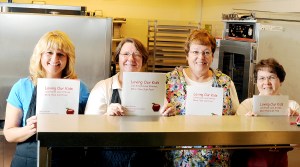LEWISTON — Carol Labonte is a Martel Elementary School lunch lady and, unofficially, a counselor, caregiver and career coach.
How she and other lunch ladies impact students is the subject of a small paperback: “Loving Our Kids, Lunchroom Love Stories … Much More Than Just Food.”
The goal is to share what cafeteria workers do, shedding the stern, anonymous, lunch-lady-in-hairnet image, said Kim Austin, nutrition director for the Lewiston School Department.
Lunch ladies make a difference in students’ lives, Austin said. The workers interact with, and know, each child.
One of the essay-style stories in the book is about how Labonte noticed a student who was “such a good kid” but often truant. When he missed school for several days, Labonte talked to him.
“I said, ‘You’ve got to come to school. Someday you’ll be old like me, and you’re going to need a job.’”
The boy loved lunchtime and wanted to volunteer in the kitchen. Labonte agreed on one condition: He had to come to school every day. “If you don’t come to school, I’m going to be in a bad place,” she told him. “I’m counting on you.”
He worked with her in the kitchen. “I won’t say he was completely there every day,” but his absenteeism improved, Labonte said.
Dolly Long works at the Farwell Elementary School cafeteria. One day after a student’s mother died unexpectedly, she found the boy “sitting in the cafeteria alone,” she wrote in the book.
“I went up to him to ask if he was OK. He cried on my shoulder. I told him if he ever needed to talk, he could always come see me.”
The two now have a connection. The student goes out of his way to say hi. “He always notices if I’m not around,” she said.
Romana Caron of the Geiger Elementary School kitchen helps several children with food allergies. One girl is allergic to gluten. Caron and the girl work together to ensure her meals are gluten-free. “She is always very thankful for the food we serve,” Caron said.
At Montello Elementary, a new kindergarten student came through the line “crying and crying,” Austin said. Lunch lady Claire Bailey dropped what she was doing and went to the child.
The 5-year-old didn’t know what to do in line. She was afraid. She finally told Bailey she wanted a peanut butter and jelly sandwich, which she got.
Those kinds of lunch stories are common, Austin said.
“Lunch is the bright spot of the day for many students,” she said. “A lot of these kids are hungry. They come to eat breakfast and lunch with us.”
Sixty-five percent of Lewiston students qualify for free or reduced-price lunches; the state average is 44 percent.
When students are in the lunch line, “every single kid is equal,” she said.
Martel Principal Stephen Whitfield said cafeteria workers at his school are invested in students. “They help us.” His staff encourages students to say “please” and “thank you.” The lunch ladies “are a big part of that,” he said. “They do it in a very friendly way.”
Each school library has a copy of the lunch ladies’ book, Austin said.


Comments are no longer available on this story